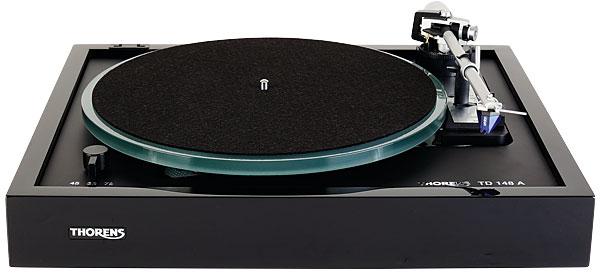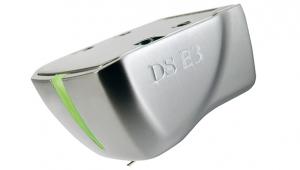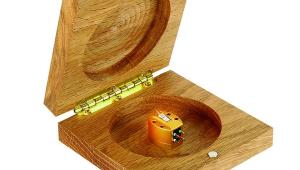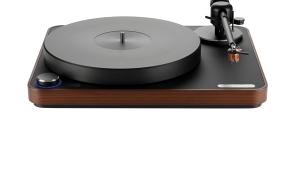Thorens TD 148A Turntable

 Fully auto turntables went out of fashion in the late '70s but Thorens has the history and experience to revive the format. Is the TD 148A in the vanguard of a new trend?
Fully auto turntables went out of fashion in the late '70s but Thorens has the history and experience to revive the format. Is the TD 148A in the vanguard of a new trend?
While fully automatic turntables have enjoyed a long history, arguably the daddy of them all was the Thorens TD-224 from 1962. Based on the TD-124, which appeared in 1957, it was able to retrieve LPs one at a time from a stack of discs located alongside the platter.
The £1499 TD 148A sits at the top of Thorens' current range of fully auto models and bears a resemblance to the company's semi-automatic TD 1601 with TP92 arm [HFN Nov '20]. However, this latest auto deck is fitted with the new TP95, another cold-drawn tube with rubber/alloy damper collar fitted midway along its length. The TP95 also includes a counterweight plus spring-loaded downforce adjustment.
The TP95's bearing housing has also been updated, sharing its styling with other Thorens models while bringing to mind those of fellow German manufacturer Dual. The reason is simple: Thorens has a production partnership with Alfred Fehrenbacher GmbH, the company behind the current range of Dual turntables, which also makes many high-quality OEM decks for other manufacturers.
Simple Set-Up
However, the essential DNA of the TD 148A is unmistakeably 'Thorens'. The plinth is available in gloss black and walnut finishes, while the heart of the deck is a belt-drive system powered by a 12V DC motor run from an external plugtop PSU. Three speeds are available, selected using a traditional keyhole-shaped switch situated on the front left-hand corner of the top plate.
The record sits on a felt mat atop a 2.3kg glass platter which, in turn, rests on a plastic sub platter. Drive to this is via a polished, Thorens-branded belt from the motor. There's no shortage of torque here and start-up time is swift, even if it's not the quietest motor I've ever encountered.
Setting up the deck is simplicity itself, but it needs to be located on a solid and level surface as the feet are neither adjustable nor especially effective at absorbing footfalls. Once positioned wisely however, it's simply a case of removing the transportation locks from the deck, fitting the belt, slipping the platter guide over the spindle and locating platter, and then placing the mat onto this.

Both tracking force and anti-skating are set using dials on and around the base of the arm's gimbal housing once the arm/cartridge has been balanced using the counterweight. The deck comes pre-fitted with a tried-and-tested Ortofon 2M Blue MM and is supplied with a self-supporting hinged dust cover that slots into hinges that drop into cut-outs on the rear of the plinth.
Absolute Marvel
Build quality of the TD 148A is of a high standard and, although its 7.9kg overall weight means it's not exactly a heavy beast, it feels good to use, with all the controls being light yet positive in action. Peek inside the plinth and the mechanism is an absolute marvel of compact and efficient engineering. I suspect the main drive cog of the old Thorens TD-224 weighed nearly as much as the TD 148A's entire mechanical internals, despite the fact they're all metal!
Operation of the deck couldn't be easier. You simply select the platter speed, set the record size lever to 30cm or 17cm and move the control lever to 'Start'. The TD 148A spins up and elegantly deposits the stylus into the lead-in groove, albeit with a bit of a thump as there is no muting facility when the mechanism is operating.
Manual start is also available – you just move the arm towards the platter to set it spinning. In either situation, when the end of the record is reached, or the control lever is moved to its 'Stop' position, the mechanism neatly lifts the arm and cartridge from the groove, returns it to the rest position and switches off the platter.
These procedures are all but foolproof, though the lack of an auto-start setting for 10in discs might be a disappointment for some, especially given that a 78rpm speed is offered. Also, the manual states that you should set the cueing lever to 'up' before operating the automatic mechanism. However, if you do this, the arm doesn't lower until you manually move the lever to 'down'. The lever needs to be left in the 'down' position for hands-free operation.
![]() Polish 'n Poise
Polish 'n Poise
When it comes to the sound of the Thorens TD 148A the key word is consistency, the deck handling bass, mid and treble with equal sensitivity. The result, if this is not too clichéd, is a turntable package that makes it easy to forget about the hi-fi and simply enjoy the music. The choice of Ortofon's 2M Blue is key to the success of this solution for although this pick-up typically brings some added sparkle, the Thorens TD 148A/2M Blue pairing sounds essentially neutral, suggesting the deck itself might have a slightly soft character. Had the partnering pick-up been selected from Ortofon's OM series, by contrast, then the overall result might well have sounded a little too relaxed, lacking incisiveness.
























































